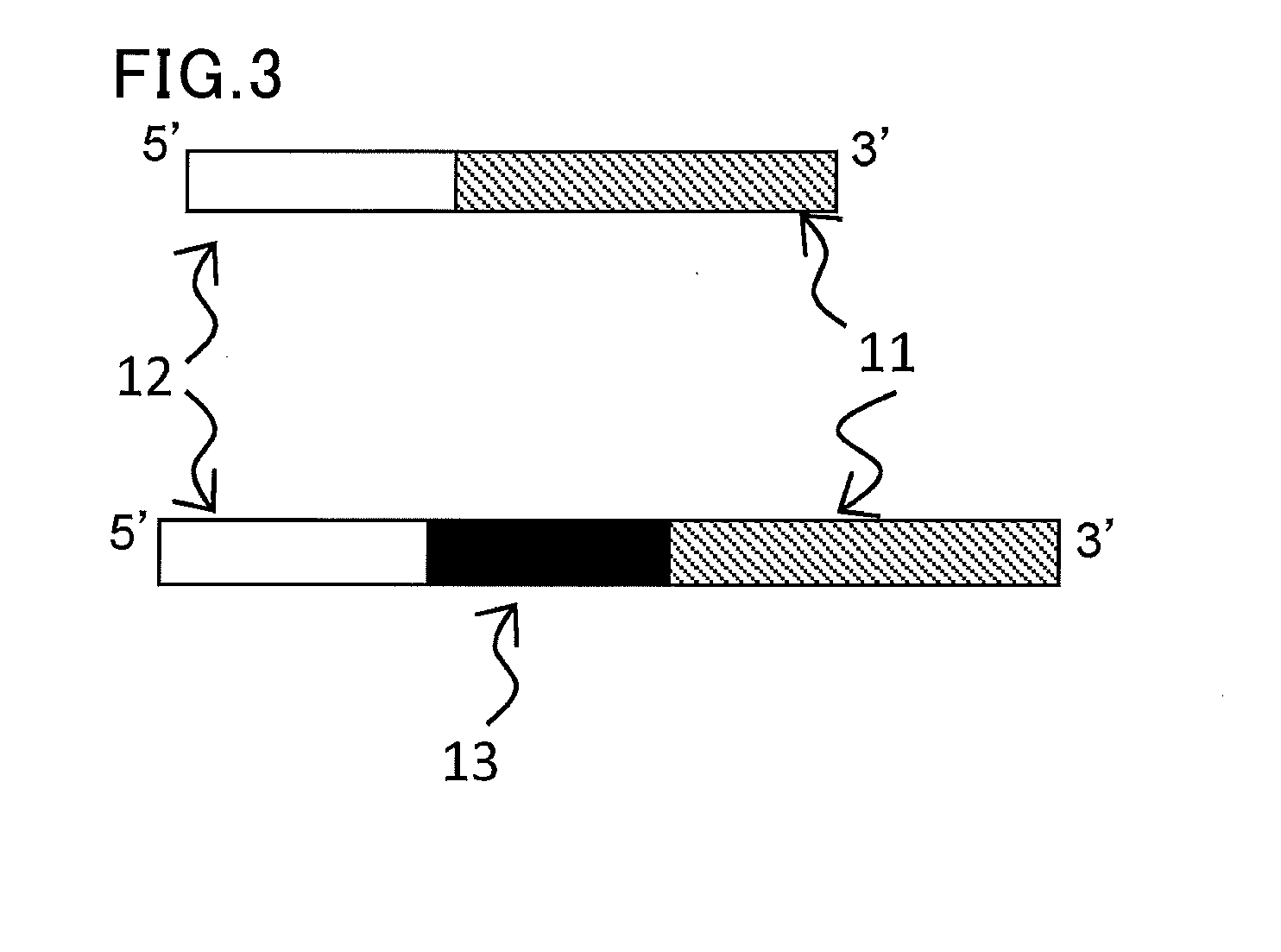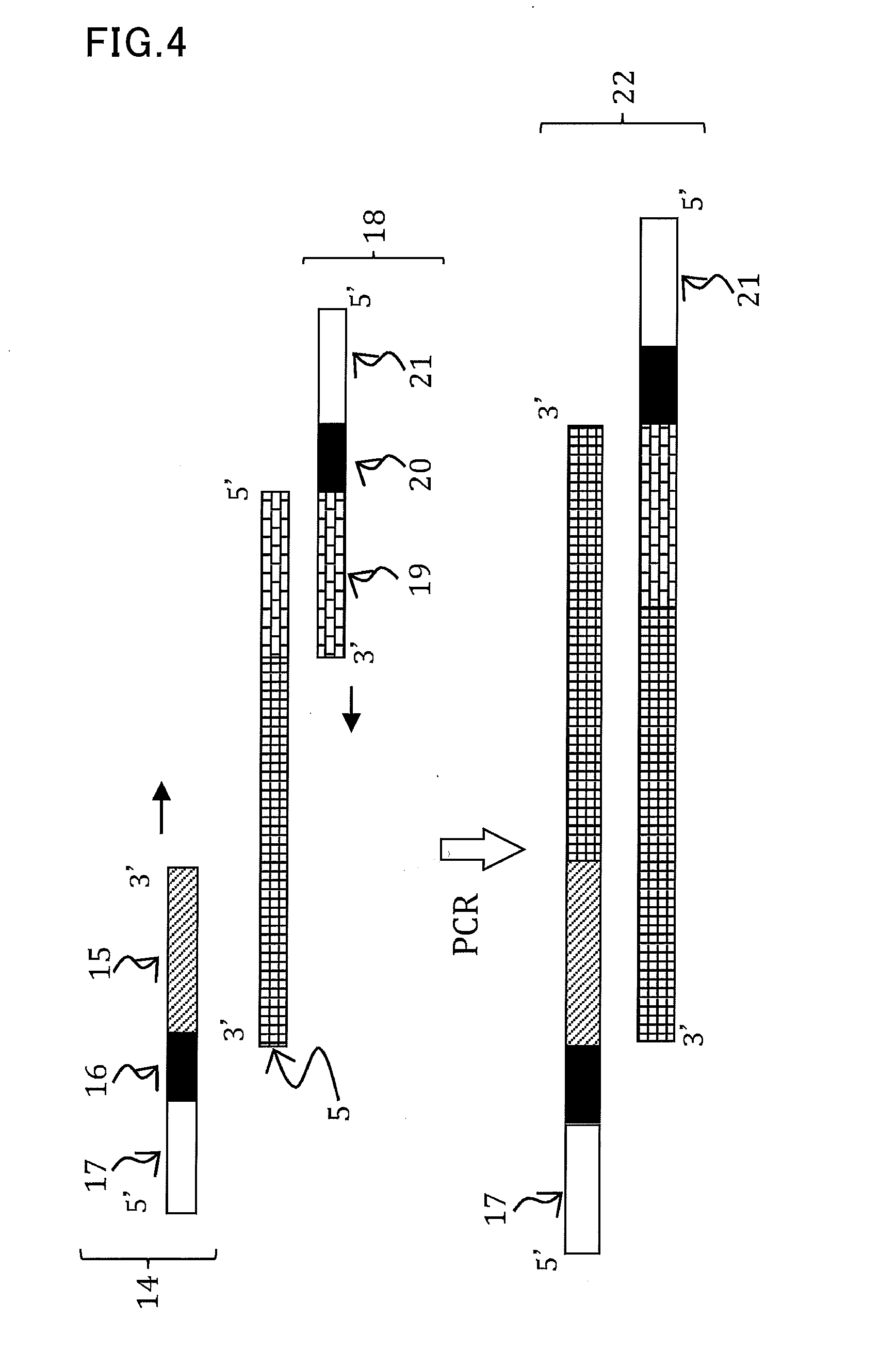Short-chain RNA detection method
- Summary
- Abstract
- Description
- Claims
- Application Information
AI Technical Summary
Benefits of technology
Problems solved by technology
Method used
Image
Examples
example 1
(1) Synthesis of RNA as Template
[0149]In the present example, a synthetic RNA (miR-156a, chain length 20 mers) which was synthesized by Tsukuba Oligo Service Co., Ltd. was used as a template.
Template miR-156a:(SEQ ID No: 1)5′-UGACAGAAGAGAGUGAGCAC-3′
(2) Synthesis of Reverse Transcription Primer
[0150]A reverse transcription primer RTp having on its 3′-end side a sequence complementary to six bases on the 3′-end side of the template miR-156a was synthesized. The primer was custom-synthesized by Tsukuba Oligo Service Co., Ltd.
RTp:(SEQ ID No: 2)5′-GTTGGCTCTGGTGCAGGGTCCGAGGTATTCGCACCAGAGCCAACGTGCTC-3′
[0151]Within the sequence of the primer, the sequence that hybridizes to the target nucleic acid is underlined.
(3) Reverse Transcription Reaction
[0152]A reverse transcription reaction was carried out using the template miR-156a synthesized in step (1) as a template and the reverse transcription primer synthesized in step (2), according to the protocol of PrimeScript (registered trademark) Hig...
example 2
(1) Extraction of Total RNA from Arabidopsis
[0161]Arabidopsis (1 g) was ground in liquid nitrogen with a mortar. Subsequently, a simple RNA extraction kit (for RT-PCR) was used according to the protocol to extract total RNA.
(2) Poly(A) Addition
[0162]A poly(A) addition reaction was performed on the RNA extracted from Arabidopsis using a poly(A) polymerase (New England Biolabs). A total of 20 μl of a mixture was prepared by adding 10× buffer (2 μl), 10 mM ATP (2 μl), the extracted RNA (2 μl), the poly(A) polymerase (1 U), and RNase-free water. The mixture was reacted at 37° C. for 10 minutes to add a poly(A) sequence to the 3′ end of the RNA.
(3) Synthesis of Reverse Transcription Primer
[0163]A reverse transcription primer RTp-T having on its 3′-end side a sequence complementary to the poly(A) portion on the 3′-end side of the RNA was synthesized. The primer was custom-synthesized by Tsukuba Oligo Service Co., Ltd. (V=A, G, or C; N=A, T, G, or C)
RTp-T:(SEQ ID No: 6)5′-GTTGGCTCTGGTGCAG...
example 3
(1) Synthesis of RNAs 1 to 3 as Templates
[0173]Synthetic RNAs 1 to 3 which were synthesized by Tsukuba Oligo Service Co., Ltd. were used as templates.
Template miRNA:(SEQ ID No: 10)5′-UGACAGAAGAGAGUGAGCAC-3′Template miRNA 2:(SEQ ID No: 11)5′-UUUGGAUUGAAGGGAGCUCUA-3′Template miRNA 3:(SEQ ID No: 12)5′-UGAUUGAGCCGCGCCAAUAUC-3′
(2) Synthesis of Reverse Transcription Primers
[0174]The following reverse transcription primers were synthesized: a reverse transcription primer RTp 1 having on its 3′-end side a sequence complementary to 6 bases on the 3′-end side of the template miRNA 1; a reverse transcription primer RTp 2 having on its 3′-end side a sequence complementary to 6 bases on the 3′-end side of the template miRNA 2; and a reverse transcription primer RTp 3 having on its 3′-end side a sequence complementary to 6 bases on the 3′-end side of the template miRNA 3. These primers were custom-synthesized by Tsukuba Oligo Service Co., Ltd.
RTp1:(SEQ ID No: 13)5′-TGGGCTGACCTAGAGGTCTTAACGTGCTC-3...
PUM
| Property | Measurement | Unit |
|---|---|---|
| Inhibition | aaaaa | aaaaa |
Abstract
Description
Claims
Application Information
 Login to View More
Login to View More - R&D Engineer
- R&D Manager
- IP Professional
- Industry Leading Data Capabilities
- Powerful AI technology
- Patent DNA Extraction
Browse by: Latest US Patents, China's latest patents, Technical Efficacy Thesaurus, Application Domain, Technology Topic, Popular Technical Reports.
© 2024 PatSnap. All rights reserved.Legal|Privacy policy|Modern Slavery Act Transparency Statement|Sitemap|About US| Contact US: help@patsnap.com










